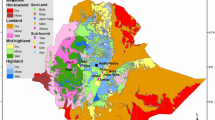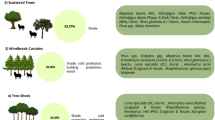Abstract
Agroecosystems can serve as multifunctional landscapes when treed habitats such as woodlots, hedgerows, riparian buffers, windbreaks, and orchards, are conserved on farms. We investigated the extent, pattern, and multifunctionality of on-farm treed habitats for 16 Vermont farms in the Lamoille watershed of the Lake Champlain Basin. The site was selected because the land use pattern is representative of the region, containing a mixture of agriculture and forest in different habitat types. We used a GIS-based approach to delineate treed habitats on farms and conducted semi-structured interviews with farmers to explore their perception of the functions of treed habitats. Through an evaluation of the relationship between farm characteristics and spatial attributes of treed habitats, we found farm size to be an important variable. Larger farms had more land in treed habitats, while the pattern of these habitats was more complex on smaller farms. Average elevation of the farm, an indicator of biophysical conditions, was a stronger predictor of the extent of treed habitats than farm characteristics. From interviews, we found that farmers benefited from alternative forest products, both for direct consumption and sale, including firewood, timber, maple sugar, edible fruits and nuts, and wood crafts. Most farmers also recognized cultural and ecological functions provided by treed habitats. These results have implications for developing policies to promote the conservation of treed habitats, considering the preferences of the landowner or farmer.











Similar content being viewed by others
References
Acharya KP (2006) Linking trees on farms with biodiversity conservation in subsistence farming systems in Nepal. Biodivers Conserv 15:631–646
Albers J (2000) Hands on the land: a history of the Vermont landscape. MIT Press, Cambridge
Altieri MA (1999) The ecological role of biodiversity in agroecosystems. Agric Ecosyst Environ 74:19–31
Angileri V, Toccolini A (1993) The assessment of visual quality as a tool for the conservation of rural landscape diversity. Landsc Urban Plan 24:105–112
Arriaza M, Cañas-Ortega JF, Cañas-Madueño JA, Ruiz-Aviles P (2004) Assessing the visual quality of rural landscapes. Landsc Urban Plan 69:115–125
Bailey S (2007) Increasing connectivity in fragmented landscapes: an investigation of evidence for biodiversity gain in woodlands. For Ecol Manag 238:7–23
Benayas JMR, Bullock JM, Newton AC (2008) Creating woodland islets to reconcile ecological restoration, conservation, and agricultural land use. Front Ecol Environ 6:329–336
Benton T, Vickery JA, Wilson J (2003) Farmland biodiversity: is habitat heterogeneity the key? Trends Ecol Evol 18:182–188
Bills N, Gross D (2005) Sustaining multifunctional agricultural landscapes: comparing stakeholder perspectives in New York (US) and England (UK). Land Use Policy 22:313–321
Boutin C, Jobin B, Belanger L, Choiniere L (2002) Plant diversity in three types of hedgerows adjacent to cropfields. Biodivers Conserv 11:1–25
Boutin C, Jobin B, Belanger L (2003) Importance of riparian habitats to flora conservation in farming landscapes of southern Quebec, Canada. Agric Ecosyst Environ 94(1):73–87
Brandon K, Gorenflo LJ, Rodrigues ASL, Waller RW (2005) Reconciling biodiversity conservation, people, protected areas, and agricultural suitability in Mexico. World Dev 33:1403–1418
Brandt J, Vejre H (2004) Multifunctional landscapes—motives, concepts and perspectives. In: Brandt J, Vejre H (eds) Multifunctional landscapes, vol 1: theory, value, and history. WIT Press, Boston
Cook PS, Cable TT (1995) The scenic beauty of shelterbelts on the Great Plains. Landsc Urban Plan 32:63–69
de Groot R (2006) Function-analysis and valuation as a tool to assess land use conflicts in planning for sustainable, multi-functional landscapes. Landsc Urban Plan 75:175–186
de Val GDLF, Atauri JA, de Lucio JV (2006) Relationship between landscape visual attributes and spatial pattern indices: a test study in Mediterranean-climate landscapes. Landsc Urban Plan 77:393–407
Deffontaines JP, Thenail C, Baudry J (1995) Agricultural systems and landscape patterns—how can we build a relationship. Landsc Urban Plan 31:3–10
Dramstad WE, Fry G, Fjellstad WJ, Skar B, Helliksen W, Sollund MLB, Tveit MS, Geelmuyden AK, Framstad E (2001) Integrating landscape-based values-Norwegian monitoring of agricultural landscapes. Landsc Urban Plan 57:257–268
Emery MR (2001) Gatherers, practices, and livelihood roles of non-timber forest products, fact sheet no. 6. Virginia Polytechnic Institute and State University, Blacksburg
Farber S, Costanza R, Childers DL, Erickson J, Gross K, Grove M, Hopkinson CS, Kahn J, Pincetl S, Troy A, Warren P, Wilson M (2006) Linking ecology and economics for ecosystem management. Bioscience 56:121–133
Fischer J, Brosi B, Daily GC, Ehrlich PR, Goldman R, Goldstein J, Lindenmayer DB, Manning AD, Mooney HA, Pejchar L, Ranganathan J, Tallis H (2008) Should agricultural policies encourage land sparing or wildlife-friendly farming? Front Ecol Environ 6:382–387
Fisher AM, Harris SJ (1999) The dynamics of tree cover change in a rural Australian landscape. Landsc Urban Plan 45:193–207
Freemark KE, Boutin C, Keddy CJ (2002) Importance of farmland habitats for conservation of plant species. Conserv Biol 16:399–412
Gliessman SR (2006) Agroecology: the ecology of sustainable food systems. CRC Press, Boca Raton
Green RE, Cornell SJ, Scharlemann JPW, Balmford A (2005) Farming and the fate of wild nature. Science 307:550–555
Groenfeldt D (2006) Multifunctionality of agricultural water: looking beyond food production and ecosystem services. Irrig Drain 55:73–83
Hein L, van Koppen K, de Groot RS, van Ierland EC (2006) Spatial scales, stakeholders and the valuation of ecosystem services. Ecol Econ 57:209–228
Jackson LE, Pascual U, Hodgkin T (2007) Utilizing and conserving agrobiodiversity in agricultural landscapes. Agric Ecosyst Environ 121:196–210
Jobin B, Belanger L, Boutin C, Maisonneuve C (2004) Conservation value of agricultural riparian strips in the Boyer River watershed, Quebec (Canada). Agric Ecosyst Environ 103:413–423
Klyza CM, Trombulak S (1999) The story of Vermont: a natural and cultural history. University of New England Press, Hanover
Kristensen SP, Thenail C, Kristensen L (2001) Farmers’ involvement in landscape activities: an analysis of the relationship between farm location, farm characteristics and landscape changes in two study areas in Jutland, Denmark. J Environ Manag 61:301–318
Kristensen LS, Thenail C, Kristensen SP (2004) Landscape changes in agrarian landscapes in the 1990s: the interaction between farmers and the farmed landscape—a case study from Jutland, Denmark. J Environ Manag 71:213–244
León MC, Harvey CA (2006) Live fences and landscape connectivity in a neotropical agricultural landscape. Agrofor Syst 68:15–26
Levin G (2007) Relationships between Danish organic farming and landscape composition. Agric Ecosyst Environ 120:330–344
Long AJ, Nair PKR (1999) Trees outside forests: agro-, community, and urban forestry. New For 17:145–174
Lovell ST, Johnston DM (2009) Creating multifunctional landscapes—how can the field of ecology inform the design of the landscape? Front Ecol Environ 7:212–220
Lovell ST, Sullivan WC (2006) Environmental benefits of conservation buffers in the United States: evidence, promise, and open questions. Agric Ecosyst Environ 112:249–260
McGarigal K, Cushman SA, Neel MC, Ene E (2002) FRAGSTATS: spatial pattern analysis program for categorical maps. www.umass.edu/landeco/research/fragstats/fragstats.html. Accessed 9 July 2009
Millenium Ecosystem Assessment (2005) http://www.maweb.org/. Accessed 20 May 2009
Miller JR (2005) Biodiversity conservation and the extinction of experience. Trends Ecol Evol 20:430–434
Montagnini F, Nair PK (2004) Carbon sequestration: an under-exploited environmental benefit of agroforestry systems. Agrofor Syst 61:281–295
Nair PKR, Allen SC, Bannister ME (2005) Agroforestry today: an analysis of the 750 presentations to the 1st World Congress of Agroforestry, 2004. J For 103:417–421
Nybakk E, Crespell P, Hansen E, Lunnan A (2009) Antecedents to forest owner innovativeness: an investigation of the non-timber forest products and services sector. For Ecol Manag 257:608–618
O’Brien EA (2006) A question of value: what do trees and forests mean to people in Vermont? Landsc Res 3:257–275
Otte A, Simmering D, Wolters V (2007) Biodiversity at the landscape level: recent concepts and perspectives for multifunctional land use. Landsc Ecol 22:639–642
Pandey DN (2007) Multifunctional agroforestry systems in India. Curr Sci 92:455–463
Pichon FJ (1997) Settler households and land-use patterns in the Amazon frontier: farm-level evidence from Ecuador. World Dev 25:67–91
Primdahl J (1999) Agricultural landscapes as places of production and for living in owner’s versus producer’s decision making and the implications for planning. Landsc Urban Plan 46:143–150
Rigby D, Woodhouse P, Young T, Burton M (2001) Constructing a farm level indicator of sustainable agricultural practice. Ecol Econ 39:463–478
Robles MD, Flather CH, Stein SM, Nelson MD, Cutko A (2008) The geography of private forests that support at-risk species in the conterminous United States. Front Ecol Environ 6:301–307
Rotz CA, Taube F, Russelle MP, Oenema J, Sanderson MA, Wachendorf M (2005) Whole-farm perspectives of nutrient flows in grassland agriculture. Crop Sci 45:2139–2159
Roy V, de Blois S (2008) Evaluating hedgerow corridors for the conservation of native forest herb diversity. Biol Conserv 141:298–307
Ruggeri J (2009) Governmental investment in natural capital. Ecol Econ 68:1723–1739
Seabrook L, McAlpine C, Fensham R (2007) Spatial and temporal analysis of vegetation change in agricultural landscapes: a case study of two brigalow (Acacia harpophylla) landscapes in Queensland, Australia. Agric Ecosyst Environ 120:211–228
Seabrook L, McAlpine C, Fensham R (2008) What influences farmers to keep trees? A case study from the Brigalow Belt, Queensland, Australia. Landsc Urban Plan 84:266–281
Smeding FW, Joenje W (1999) Farm-nature plan: landscape ecology based farm planning. Landsc Urban Plan 46:109–115
Sood KK, Mitchell CP (2009) Identifying important biophysical and social determinants of on-farm tree growing in subsistence-based traditional agroforestry systems. Agrofor Syst 75:175–187
USDA (United States Department of Agriculture) Economic Research Service (2009) State fact sheets. http://www.ers.usda.gov/StateFacts/. Accessed 20 May 2009
USDA (United States Department of Agriculture) National Agricultural Statistics Service (2009) 2007 census of agriculture. http://www.agcensus.usda.gov/. Accessed 20 May 2009
USDA (United States Department of Agriculture) Natural Resource Conservation Service (2006) Farmland classification systems for Vermont soils. http://www.nrb.state.vt.us/lup/publications/importantfarmlands.pdf. Accessed 15 July 2009
Vandermeer J, Perfecto I (2007) The agricultural matrix and a future paradigm for conservation. Conserv Biol 21:274–277
Vermont Agency of Natural Resources (2008) Lamoille river basin—water quality management plan, interim final plan. Water Quality Division, Department of Environmental Conservation, Agency of Natural Resources, Waterbury, Vermont, p 101
Vermont Department of Environmental Conservation (2001) Lake Champlain basin agricultural watersheds, section 319 national monitoring program project. http://www.anr.state.vt.us/dec//waterq/planning/htm/pl_319watershed.htm. Accessed 16 July 2009
Vermont Department of Environmental Conservation (2008) Lamoille river basin planning. http://www.anr.state.vt.us/dec//waterq/planning/htm/pl_lamoille.htm. Accessed 20 May 2009
Westergaard K (2006) The landscape composition of organic and conventional, dairy and crop farms in two different geological regions in Denmark. Agric Ecosyst Environ 117:63–70
Weyerhaeuser H, Kahrl F (2006) Planting trees on farms in southwest China—enhancing rural economies and the environment. Mt Res Dev 26:205–208
Wiggering H, Muller K, Werner A, Helming K (2003) The concept of multifunctionality in sustainable land development. In: Helming K, Wiggering H (eds) Sustainable development of multifunctional landscapes. Springer, Berlin, p 283
Willemen L, Verburg PH, Hein L, van Mensvoort MEF (2008) Spatial characterization of landscape functions. Landsc Urban Plan 88:34–43
Wood N, Halbrendt C, Liang K, Wang Q (2000) Interdependence of agriculture and tourism: quantifying the value of the agricultural working landscape in Vermont. American Agricultural Economics Association Annual Meeting, Tampa
World Agroforesty Centre (2008) http://www.worldagroforestrycentre.org/. Accessed 20 May 2009
Acknowledgements
We thank the participating farmers for the time they committed to this effort. We are also grateful to Jim Eikenberry of Lamoille County, Vermont NRCS office, for providing valuable time and support throughout the research process.
Author information
Authors and Affiliations
Corresponding author
Rights and permissions
About this article
Cite this article
Lovell, S.T., Mendez, V.E., Erickson, D.L. et al. Extent, pattern, and multifunctionality of treed habitats on farms in Vermont, USA. Agroforest Syst 80, 153–171 (2010). https://doi.org/10.1007/s10457-010-9328-5
Received:
Accepted:
Published:
Issue Date:
DOI: https://doi.org/10.1007/s10457-010-9328-5




